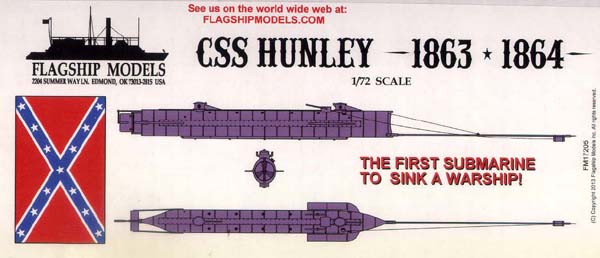
Reviewed by Timothy Dike
November 2013

|
H.L. Hunley, a small, hand-powered submarine, was privately built at Mobile, Alabama, in 1863, based on plans furnished by Horace Lawson Hunley, James R. McClintock and Baxter Watson. Following trials in Mobile Bay, she was transported to Charleston, South Carolina, in August 1863 to serve in the defense of that port. On 29 August, while moored to a steamer, the submarine was accidentally pulled over on its side and sank, drowning five members of her crew. After salvage, she was given a new crew and began a series of tests. However, during diving trials on 15 October 1863, she failed to surface. Horace Lawson Hunley, who was directing her operation, and the rest of her men were drowned. H.L. Hunley was again raised and repaired. With a third crew, and under orders to only operate on the surface, she began a series of attempts to attack United States Navy ships on blockade duty off Charleston. On 17 February 1864, these efforts were successful. H.L. Hunley approached the steam sloop of war USS Housatonic and detonated a spar torpedo against her side. The Federal ship sank rapidly, becoming the first warship to be lost to a submarine's attack. However, H.L. Hunley did not return from this mission, and was presumed
lost with all hands. Her fate remained a mystery for over 131 years, until
May 1995, when a search led by author Clive Cussler located her wreck.
On 8 August 2000, following extensive preliminary work, the H.L. Hunley
was raised and taken to a conservation facility at the former Charleston
Naval Base. At present, she is the subject of a careful preservation effort
that ultimately should place her in suitable condition for general public
exhibition.
|
|||||||||
| HULL | |||||||||
| The hull is a single piece with recessed panel lines and raised rivet heads. The casting gate is on the end where removal will cause the least work to clean up around. |
to enlarge |
||||||||
|
|||||||||
| RESIN DETAILS | |||||||||
| Two turrets with entry hatches are cast with lots of detail. A snorkel box with two tiny snorkels are included. Dive plans and rudder look crude as they were on the real sub. A propeller guard is provided in cast resin, however there is also a photo etch option. | |||||||||
|
|||||||||
| PHOTO ETCH | |||||||||
| A relief etch brass photo etch fret is provided with a propeller, alternate propeller guard and mooring cleats. Plastic strips for the rudder supports is provided as well as brass rod for the torpedo spar. | |||||||||
| INSTRUCTIONS | |||||||||
The Instructions very well done with sharp clear subassembly
views with clear call outs. Parts are clearly labeled and details with
dimensions are provided for the torpedo spar. A plan and elevation view
with parts location will be a great help.
|
|||||||||
| CONCLUSIONS | |||||||||

This is a nice large scale version of the first combat sub to sink an enemy ship. It would make an interesting companion to one of those new 1/72 scale Gato's. This is kit #FM12705 CSS Hunley (11.75" long) listed for $50.00, available direct from Flagship Models via it's online ordering system. With such a simple shape the painting and weathering be what makes this kit standout. Not to worry, as Flagship has a line of How to CD's that will help you out in many topics from Building Resin Ships and Working with Photo Etch Parts to Making Realistic Water. |
|||||||||
